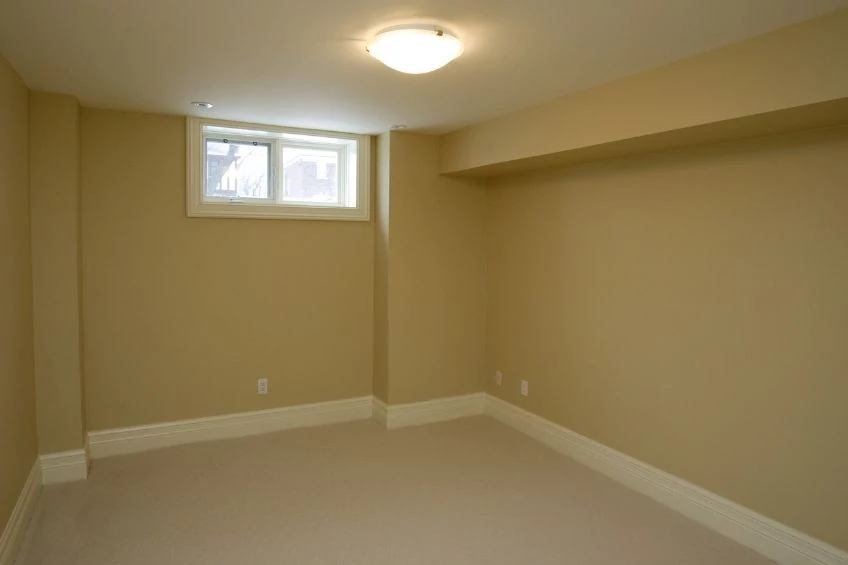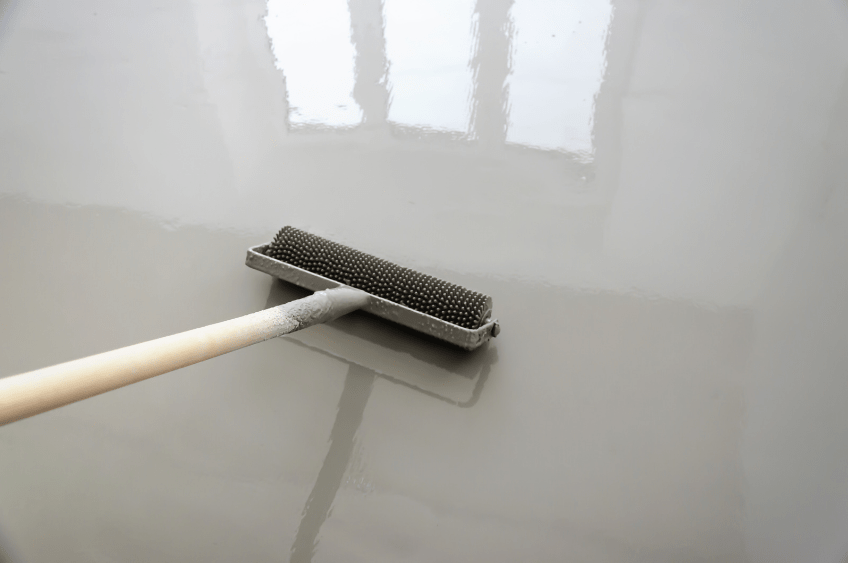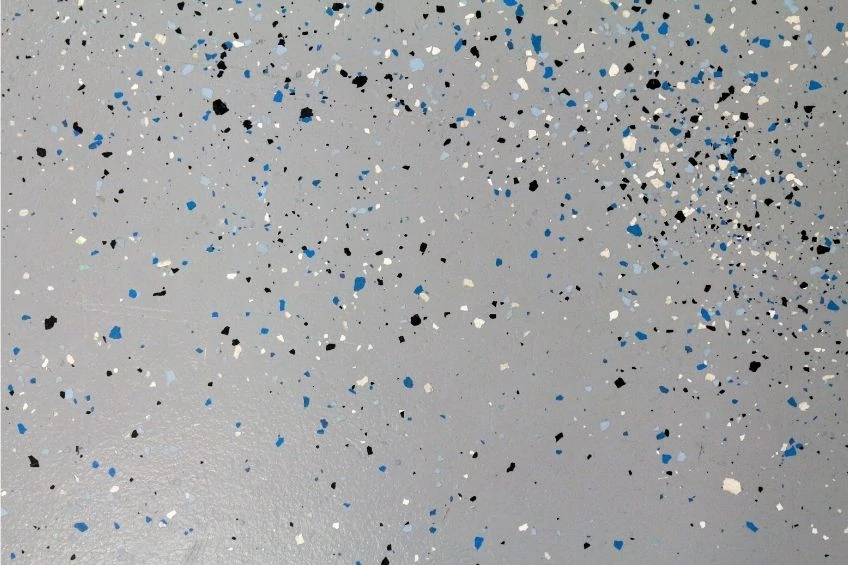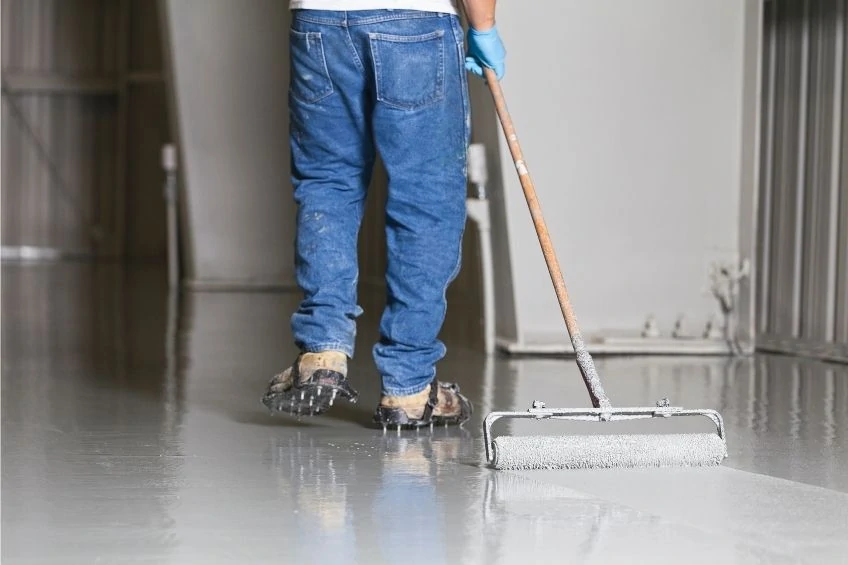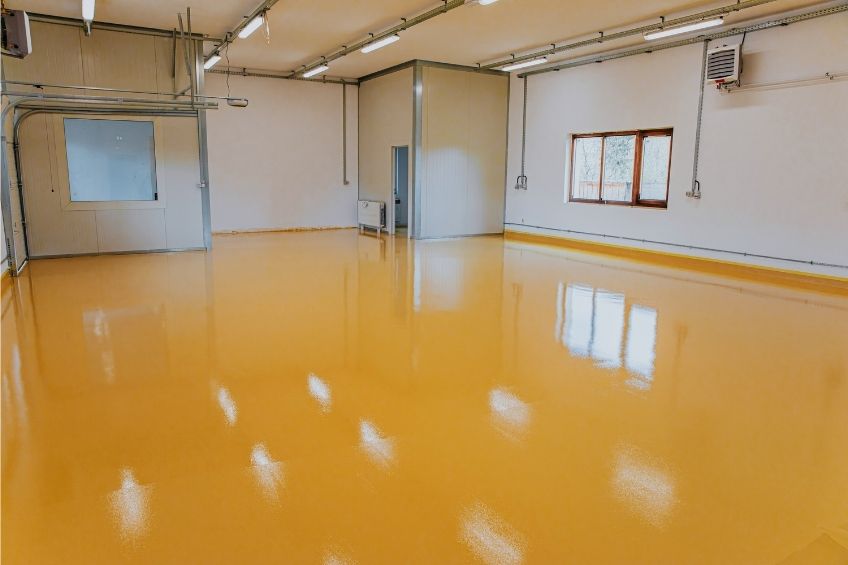Best Basement Cement Floor Paints – Our Complete Guide
This post may contain affiliate links. We may earn a small commission from purchases made through them, at no additional cost to you. You help to support resin-expert.com
Painting concrete floors is never easy. While the paint should look good, it needs to provide a number of special qualities. This includes things like being water-resistant, and durable enough to withstand heavy wear and tear. Basement cement floor paint should be applied to help protect the concrete foundation of the basement while making the place look more inviting. Are you struggling to find the best basement waterproofing paint? We have put together a straightforward guide below on everything you need to know about basement concrete floor paint, how to choose it, and how to use it.
Table of Contents
- What Makes Basement Concrete Floor Paint Special?
- What is the Best Paint for Basement Floors?
- The Best Basement Cement Floor Paint
- Considerations for the Best Basement Cement Floor Paint
- How to Apply Basement Concrete Floor Paint
- Tips and Tricks for Basement Concrete Floor Paint
- Frequently Asked Questions
What Makes Basement Concrete Floor Paint Special?
You can’t just use any paint for basement floors. Basement cement floor paint needs to contain certain features to help protect the concrete underneath. This is not only a visual paint, but it also acts as an important waterproofer and layer of protection. Typically, basements are dark, damp places. They may be home to washing machines, workshops, or heavy storage containers. Because of all this, the best basement paint should be strong enough to endure this.
First of all, basement cement floor paint should provide a waterproofing seal over the concrete. Concrete is a very porous substance, and when it absorbs moisture it can start to crack or crumble. It is important to add a layer of concrete basement floor sealer to protect the floor from this.
Basement cement floor paint also needs to be particularly durable. Unlike the paint you may use on your walls, this paint needs to hold up against foot traffic and heavy items. This paint needs to be particularly strong and impact resistant. It should also not peel, crack, or blister if exposed to moisture and dampness – something that is often present in basements.
What is the Best Paint for Basement Floors?
It is essential to choose the right type of paint for painting your concrete floor. While there are many different options available, epoxy floor paint is the best paint for basement floors. This type of paint contains a small amount of epoxy which helps to add an additional layer of protection to the paint.
Epoxy paint works as a sealer as well as a paint. This is ideal because it eliminates the need for an additional basement food sealer coating. The sealed paint will be able to withstand heavy use, spills, scratches, and more.
The Best Basement Cement Floor Paint
Finding the right basement concrete floor paint can be tricky, as you need to make sure that you bug an effective, long-lasting, protective solution. To make your choice easier, we have selected the absolute top products for our concrete basement floor paint reviews below. These paints are suitable for all kinds of basements or garages and are easy to use for any DIY enthusiasts.
Best Basement Paint: KILZ Epoxy Concrete and Garage Floor Paint
This option by Kilz is our top pick as a basement concrete floor paint. The paint is a unique 1-part epoxy acrylic mixture that is suitable for both interior and exterior use. This paint is highly durable, easy to clean, and won’t scuff, fade, or crack over time. The paint is designed to withstand hot tires and all kinds of heavy activity.
This is a water-based concrete floor paint that is resistant to staining from oil, chemicals, and gasoline. It delivers a satin finish that is smooth and easy to apply. The paint dried fairly quickly and is only suitable for flooring. If you are after a basement concrete floor paint that looks great and provides a high level of durability and resistance to foot traffic and general wear and tear, then this option by Kilz is the answer.
- A highly durable and versatile epoxy floor paint
- An easy to use single-component water-based paint
- A smooth satin finish for interior/exterior painting
PROS
- The paint offers a high level of durability
- Easy to apply – no mixing required
- Resists chemicals and hot tire pick-up
- Dries to a slip-resistant stain finish
- Great for basements, garages, driveways, and decks
- Water-based for safer use
CONS
- Does not perform the same as a two-part epoxy solution
Best Basement Waterproofing Paint: DRYLOK Basement and Masonry Waterproofer
If waterproofing is your main concern, then this product by Drylok is your best bet. The waterproofer dries to a bright white color and is guaranteed to stop water in your basement. This basement waterproofing floor paint can withstand 15 PSI for excellent protection against water.
This basement and masonry waterproofer looks fantastic when applied. Its smooth white finish can transform any dark basement. The formula is greenwise certified and meets all current VOC requirements. This basement waterproofing paint is tintable, ultra-smooth, and easy to apply.
- Guaranteed to stop water at 15 PSI
- Ultra-smooth, tintable, and easy to apply
- Low odor formula that is fully VOC compliant
PROS
- Guaranteed to stop water at a high pressure
- Penetrates the pores of a surface for better water protection
- Easy to apply
- Long-lasting and ages well
CONS
- The paint is very thick and takes a long time to dry
Premium Waterproofer: KILZ Basement and Masonry Waterproofing Paint
Kilz has developed one of the best waterproofers available with this basement waterproofing paint. Firstly, we need to specify that this is not necessarily recommended as floor paint. So, why have we included it on this list? The paint is still incredibly durable, and it provides an excellent level of waterproofing in basements. When combined with a basement floor sealer, you can achieve the ultimate floor finish. However, the paint is still a good choice for flooring as it is, you will just end up with a lot of footprints left behind on the white paint.
This acrylic formula can withstand 12 PSI of water pressure. It provides a mildew-resistant finish and is alkali resistant. This paint is suitable for interior and exterior use thanks to its high level of durability. The long-lasting white finish can be applied to a wide range of surfaces.
- A premium interior/exterior waterproofing paint
- Alkali and mildew resistant, and withstands 12 PSI of water
- Provides a long-lasting, durable, and decorative finish
PROS
- Offers an excellent waterproofing solution
- Long-lasting formula
- Dries to an attractive white finish
- Mildew and alkali resistant
CONS
- Requires quite a lot of preparation before painting
- Not specifically designed as a floor paint
Best Anti-Slip Paint: FIXALL Skid Grip Resistant Textured Coating
This basement cement floor paint has been formulated with a textured surface to make it safer and more grippy. The acrylic textured paint can be used over all kinds of surfaces to provide a good level of grip. It is suitable for indoor and outdoor use and is fairly easy to apply.
The high-grip finish increases safety, and it is highly resistant. Once applied, this anti-slip paint will provide a long-lasting finish for all types of areas. The paint also looks great and is available in a wide range of colors. These colors are fade-resistant so will continue looking great over many years.
- An acrylic textured anti-slip paint
- An indoor or outdoor skid-resistant paint
- Available in multiple colors and adheres to most surfaces
PROS
- A textured anti-slip paint
- Suitable for interior or exterior use
- Highly durable and weather-resistant
- Non-fading colors and long-lasting finish
- A wide range of colors available
CONS
- The colors can come out slightly different to the picture
- The paint can have scuff marks left on it
Considerations for the Best Basement Cement Floor Paint
Finding the best basement cement floor paint can be a little bit confusing at first. There are so many different types of paint available, all with unique properties and features. So, what should you look out for when choosing the best basement paint? We have outlined a few important considerations below.
Waterproofing
Many people will look for basement waterproofing paint first. Waterproofing paint is important for basements because these tend to be quite damp, dark places. If there is a water leak in your basement, the concrete will absorb that water and start to crack and damage. This is why it is important to use basement waterproofing paint.
Special basement waterproofing paints are measured by the PSI that the paint can handle. Not all paints offer this type of waterproofing functionality. Just remember that you can also use regular floor paint, and seal it with a waterproofing coating.
Oil-Based or Water-Based
There are various different paint formulas available, but the main difference is whether you go for an oil-based or water-based product. Water-based paints are often preferred for basement floors due to the fact that they emit fewer harmful odors and contain a lower VOC level. Therefore, they are much safer to work with indoors.
However, oil-based paints are more durable which is important for flooring that experiences a lot of wear and tear. These paints take longer to dry and have strong odors while still wet, but once cured they form a long-lasting, durable coating.
The Type of Paint
There are various different types of paint that can be used for cement floors. The best option is epoxy paint. This is a type of acrylic latex paint with a small amount of epoxy mixed into the formula. Epoxy paint is ideal for use on flooring thanks to its hard finish and long-lasting durability. If the paint is not specifically formulated for use as a food paint, then you may want to apply a basement floor sealant over the paint for better protection.
Epoxy paints are available in three different varieties. These are water-based, solvent-based, or 100% solid. Epoxy paints are popular because they provide their own sealant, so do not require an additional sealant coat.
Protection
Besides being waterproof, the best basement cement floor paint should offer a good level of protection against other elements. This should include things like mildew-resistance and scratch-resistance. If you are painting a garage floor, then the paint should also be resistant to hot tire pick-up.
The paint can also offer protection against chemical spills, oil, gasoline, and so on. This is important depending on what the floor will be used for. If the paint does not offer a particularly good level of protection, you can always add a sealer on top for this.
Maintenance
The best basement cement floor paint should be easy to clean and maintain. Epoxy paints offer this easy maintenance aspect which is one of the reasons why they are so popular. You want to be able to easily wipe any spills or marks off the paint. The paint should also be long-lasting without the need for regular reapplication.
Type of Epoxy
True epoxy consists of two parts that need to be mixed together. This offers a really durable epoxy finish. Epoxy paint is generally not this type of epoxy, but it rather comes as a single component product. This is easier to use and more appealing to most DIYers. If you are looking for a stronger form of clear epoxy, then you will need to buy a two-part kit.
How to Apply Basement Concrete Floor Paint
Now that you have chosen the best basement cement floor paint, it’s time to apply it. This may take a bit of effort, but you will end up with long-lasting, high-quality results. Be sure to follow these guidelines properly to ensure the strongest, most durable finish. Luckily, applying basement cement floor paint can be done fairly easily at home without professional help.
Assess the Basement Conditions
Basements are not easy rooms to maintain when it comes to painting. Because of their level, basements are generally quite humid or damp. Before you start painting, you should make sure that all steps have been taken to resolve any moisture issues.
If the basement is too humid, it could easily cause the paint to blister or peel. We would recommend adding a dehumidifier to sort this out. This will help the paint to dry better, as well as make the basement more comfortable. It will also help to prevent mold and mildew growth.
Some basement may also have flooding potential. Make sure that all steps have been taken to address this. This can involve sloping the ground soil around the outside of the basement, or making sure that the gutters are working properly.
Prepare the Surface
Even the best basement cement floor paint will not fully cover up the bumpy texture of concrete. Basement concrete floors can be quite messy, with paint splutters, bumps, cracks, and marks. To make sure that you get the most attractive finis from your basement floor waterproofing paint, you will need to prepare the floor surface properly in advance.
Start by scraping away any paint or residue that is already on the floor. Then you will need to give the floor a good clean. We recommend using a pressure washer for the best results. Scrub away any tough dirt or stains so that you have a clean exposed concrete surface to work with.
Special degreaser formulas are available for cleaning concrete surfaces. If there are existing patches of dirt, oil, paint splatters, etc this will affect the adhesion properties of the basement cement floor paint. It may also result in patchy areas forming.
The final step of preparation is to fill in any existing cracks or missing areas of concrete. This shouldn’t be the case if you are painting new concrete. The reason you are applying a new coat of basement concrete floor paint may be to protect it from further cracks forming.
There are a few different choices for repairing cracks in concrete. We recommend using an epoxy concrete crack filler for any small cracks or gaps. This will dry to an incredibly durable finish and can withstand heavy foot traffic. Make sure to apply the filler in accordance with the manufacturer’s guidelines, and give it enough time to cure fully.
Protect Your Area
Before starting to apply any basement floor waterproofing paint or primer, you should make sure that the area is safe for painting. Use masking tape, newspaper, or plastic sheeting to cover any areas that you don’t want to be painted. This includes the bottom of the walls, pillars, skirting, columns, radiators, and so on. Painting can be a messy business, so it is really important that you protect these surfaces in advance. Otherwise, cleaning them can be a difficult task.
Priming
Now that the concrete floor surface is ready, it is time to start painting. Before applying the basement concrete floor paint, you should prime the surface. Priming is not essential for all paints, but we recommend it for improving the adhesion properties of the floor. This will also result in a more durable, long-lasting floor paint.
Be sure to use a primer that works with the type of paint you are using. A good general rule is to use an oil-based primer with oil-based paint, and a water-based primer with water-based paint. The primer also needs to be compatible with both concrete and the epoxy paint that you will be using. Lastly, make sure that the primer is suitable for interior use if painting a basement. Apply the primer to the concrete floor only when the surface is completely dry. Use a paint roller to apply an even coat of the primer, then leave it to dry fully. This may need to be left overnight.
Applying the Paint
Once the floor has been prepared and primed, it is time to start painting. Using a paint roller on an extendable pole, you can start to apply the paint. Paint in long, even strokes for a uniform finish. Make sure that you start in the far end of the basement, and paint backward towards the door. Then leave the paint to dry.
Once fully dried, you can apply the second coat. The number of coats that you use will depend on the surfaces you are painting and the type of paint that you are using. You can check out the concrete basement floor paint reviews to find out recommendations on the number of coats to use.
Apply a Concrete Basement Floor Sealer
Once the epoxy floor paint has dried, you can choose to add a concrete basement floor sealer. This is not an essential step, but it is recommended for longer-lasting results. Choose the right sealer depending on the surface you are sealing (basements will require an interior sealer).
Apply the sealer just like you did the paint. Make sure that it is evenly coated across the entire room, and then leave it to cure. Once the sealer has cured fully, the new basement floor will be ready to use.
Best Basement Floor Sealer: RUST-OLEUM Epoxy Shield Basement Floor Kit
This is an easy solution for basement cement floors as you get an entire kit that provides the ultimate floor finish. This kit can be used to transform basement floors into comfortable, attractive living spaces. This basement floor sealer is a water-based epoxy formula that is safe and easy to use. It cures to a smooth satin finish that is long-lasting and durable. The product can even be used on basement walls too.
- Easy to clean attractive satin finish
- A full epoxy floor kit that offers a durable solution
- Easy to apply and long-lasting low odor formula
Pros
- Easy to use and apply
- Seals basement floors for a greater level of protection
- Dries to an attractive, smooth finish
- Water-based formula that is safe to use
- Transforms floors into comfortable living spaces
Cons
- It takes a long time to dry
Tips and Tricks for Basement Concrete Floor Paint
Applying the basement cement floor paint is easy enough to do yourself. To get the perfect finish though, you may need to follow a few special techniques. We have put together our top tips and tricks below for anyone wanting to get the perfect finish for their cement floor paint.
- Washing up: Most concrete floor paints are water-based, which means that they can be cleaned up pretty easily with just soap and water. Before you start painting, it is advisable to have a bucket of soapy water with a cloth ready. This can be used to quickly clean up any paint splatters that may occur on the walls or furniture.
- Removing the tape: After the sealant dries, you should make a cut with a blade along the masking tape that you sealed the area off with before removing it. This allows you to get a perfectly clean, straight edge. Otherwise, the tape may tear or take some sealant or paint with it.
- Staying safe: It is always a good idea to wear protective gear when painting basement floors. Basements do not offer very good airflow, so you should have a respirator mask available when painting. Different paints have different levels of odors, but in confined spaces like basements, it is always important to wear a mask while painting.
- Adding texture: You can always add special floor texture products to epoxy paint if you are concerned about slipping. Anti-slip texture works well with epoxy paint or sealants, making slippery floors safer to walk on.
- Mixing the epoxy: If you are using two-part epoxy, then you will need to mix the paint before use. As soon as you mix it, the paint will start the curing process. This means you will have limited time to work with the paint before it all dries., for this reason, it is best to only mix smaller amounts at a time.
- Drying: Make sure that you leave the paint to fully dry before using the room. This can take up to 12 hours, but we recommend leaving it for 24 hours to be safe.
Frequently Asked Questions
How Long Does Concrete Floor Paint Last?
This depends on the type of paint you use and where it is applied. If durable paint is used and properly applied, it can last around 15 years. Some paints may need reapplication after about three years if they are affected by heavy wear and tear.
How Long Should Concrete Floor Paint Dry?
Even if the paint dries to touch within an hour, you should leave it for about 4 hours before applying a second coat. Of course, this varies depending on the paint being used. Once you have applied the final coat, we recommend leaving the paint to dry for 24 hours before walking on the floor.
What is the Best Basement Cement Floor Paint?
Epoxy paint is widely regarded as the best option for use on floors. This type of paint seals itself and provides a long-lasting durable coating that can withstand heavy use.
Why Paint Your Concrete Basement Floor?
Painting over the concrete floor in your basement is highly recommended. It should be done for waterproofing which adds a necessary protective barrier over the concrete. The floor will also look much more inviting, and can increase the value of your house.
Can You Use Regular Paint for Concrete Floors?
You can paint over concrete with most types of paint. However, this will not last very long and will leave marks and footprints. Special floor paint is a far superior option that will help to protect the concrete and provide a durable, long-lasting finish.
Applying a basement cement floor paint is an easy way to completely uplift your basement. Not only does this make the space more beautiful, but it adds a necessary layer of protection over the concrete. This will help to protect the concrete against water damage and cracking. Follow our step-by-step guide above for an easy basement painting process. We hope your project is a great success!


